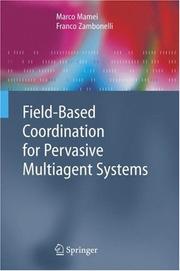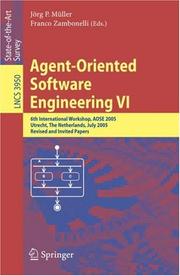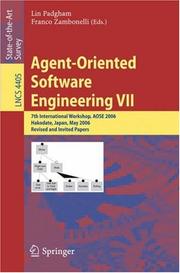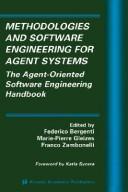| Listing 1 - 10 of 28 | << page >> |
Sort by
|
Book
ISBN: 9783031621468 Year: 2024 Publisher: Cham : Springer International Publishing : Imprint: Springer,
Abstract | Keywords | Export | Availability | Bookmark
 Loading...
Loading...Choose an application
- Reference Manager
- EndNote
- RefWorks (Direct export to RefWorks)
This book provides an overview of the many approaches that can adopted for programming and deploying highly-adaptive and large-scale IoT systems, with a specific focus on the key results achieved within the Fluidware research project. The authors start by presenting Fluidware, which develops a novel programming model for IoT services and applications, along with the associated and robust large-scale IoT services and applications. Starting from previous findings in the areas of field-based coordination, collective adaptive systems, stream computing and aggregate computing, the authors address the complexity of building modern, large-scale IoT systems, by a full-fledged engineering approach revolving around a new notion of distributed programming. The authors show how the key innovative idea of Fluidware is to abstract collectives of devices of the IoT fabric as sources, digesters, and targets of distributed "flows" of contextualized events, carrying information about data produced and actuating commands. The book is divided into three parts: (i) the first part is a general introduction to the Fluidware ideas and to the key problems associated with programming IoT systems, (ii) the second part presents the key results achieved within the Fluidware project; (iii) the third part identified open challenges and research directions. Provides an overview of approaches for programming and deploying highly-adaptive and large-scale IoT systems; Focuses on the key results achieved within the Fluidware research project, which develops a novel programming model for IoT services and applications; Presents results achieved within the Fluidware project and identifies open challenges and research directions.

ISBN: 1280608676 9786610608676 3540279695 3540279687 3642066232 Year: 2006 Publisher: Berlin ; New York : Springer,
Abstract | Keywords | Export | Availability | Bookmark
 Loading...
Loading...Choose an application
- Reference Manager
- EndNote
- RefWorks (Direct export to RefWorks)
More and more, software systems involve autonomous and distributed software components that have to execute and interact in open and dynamic environments, such as in pervasive, autonomous, and mobile applications. The requirements with respect to dynamics, openness, scalability, and decentralization call for new approaches to software design and development, capable of supporting spontaneous configuration, tolerating partial failures, or arranging adaptive reorganization of the whole system. Inspired by the behaviour of complex natural systems, scientists and engineers have started to adjust their mechanisms and techniques for self-organization and adaption to changing environments. In line with these considerations, Mamei and Zambonelli propose an interaction model inspired by the way masses and particles in our universe move and self-organize according to contextual information represented by gravitational and electromagnetic fields. The key idea is to have the components’ actions driven by computational force fields, generated by the components themselves or by some infrastructures, and propagated across the environment. Together with its supporting middleware infrastructure – available with additional information under http://www.agentgroup.unimore.it – this model can serve as the basis for a general purpose and widely applicable approach for the design and development of adaptive distributed applications.
Evolutionary programming (Computer science) --- Adaptive computing systems --- Distributed artificial intelligence. --- Embedded computer systems --- Design. --- Programming. --- DAI (Artificial intelligence) --- Distributed AI (Artificial intelligence) --- Artificial intelligence --- Adaptive computing --- Configurable computing systems --- Reconfigurable computing systems --- Computer systems --- Computer programming --- Information Technology --- Artificial Intelligence --- Artificial intelligence. --- Computer Communication Networks. --- Software engineering. --- Artificial Intelligence. --- Software Engineering. --- Computer software engineering --- Engineering --- AI (Artificial intelligence) --- Artificial thinking --- Electronic brains --- Intellectronics --- Intelligence, Artificial --- Intelligent machines --- Machine intelligence --- Thinking, Artificial --- Bionics --- Cognitive science --- Digital computer simulation --- Electronic data processing --- Logic machines --- Machine theory --- Self-organizing systems --- Simulation methods --- Fifth generation computers --- Neural computers --- Computer communication systems. --- Communication systems, Computer --- Computer communication systems --- Data networks, Computer --- ECNs (Electronic communication networks) --- Electronic communication networks --- Networks, Computer --- Teleprocessing networks --- Data transmission systems --- Digital communications --- Electronic systems --- Information networks --- Telecommunication --- Cyberinfrastructure --- Network computers --- Distributed processing
Digital
ISBN: 9783540279693 Year: 2006 Publisher: Berlin, Heidelberg Springer-Verlag Berlin Heidelberg
Abstract | Keywords | Export | Availability | Bookmark
 Loading...
Loading...Choose an application
- Reference Manager
- EndNote
- RefWorks (Direct export to RefWorks)
Multi
ISBN: 9783540709459 Year: 2007 Publisher: Berlin, Heidelberg Springer-Verlag Berlin Heidelberg
Abstract | Keywords | Export | Availability | Bookmark
 Loading...
Loading...Choose an application
- Reference Manager
- EndNote
- RefWorks (Direct export to RefWorks)
Software architectures that contain many dynamically interacting components, each with their own thread of control, and engaging in complex coordination protocols, are difficult to correctly and efficiently engineer. Agent-oriented modelling techniques are important for supporting the design and development of such applications. This book provides a diverse and interesting overview of the work that is currently being undertaken by a growing number of researchers and research groups in the area of Agent-Oriented Software Engineering. The papers present leading edge research in this field, which is of critical importance in facilitating industry take-up of powerful agent technologies. This volume constitutes the thoroughly refereed post-proceedings of the 7th International Workshop on Agent-Oriented Software Engineering, AOSE 2006, held in Hakodate, Japan, in May 2006 as part of AAMAS 2006. The 13 revised full papers were carefully selected from numerous submissions during two rounds of reviewing and improvement and have been complemented by invited papers from leading researchers in the field. The papers are organized in topical sections on modelling and design of agent systems, modelling open agent systems, formal reasoning about designs, as well as testing, debugging and evolvability.
Computer science --- Programming --- Computer architecture. Operating systems --- Artificial intelligence. Robotics. Simulation. Graphics --- Computer. Automation --- programmeren (informatica) --- programmeertalen --- software engineering --- KI (kunstmatige intelligentie) --- computernetwerken --- robots --- AI (artificiële intelligentie)
Digital
ISBN: 9783540340997 Year: 2006 Publisher: Berlin Heidelberg Springer-Verlag GmbH
Abstract | Keywords | Export | Availability | Bookmark
 Loading...
Loading...Choose an application
- Reference Manager
- EndNote
- RefWorks (Direct export to RefWorks)
Computer science --- Programming --- Computer architecture. Operating systems --- Artificial intelligence. Robotics. Simulation. Graphics --- Computer. Automation --- programmeren (informatica) --- programmeertalen --- software engineering --- KI (kunstmatige intelligentie) --- computernetwerken --- robots --- AI (artificiële intelligentie)

ISBN: 9783540340973 3540340971 3540340998 Year: 2006 Publisher: Berlin ; New York : Springer,
Abstract | Keywords | Export | Availability | Bookmark
 Loading...
Loading...Choose an application
- Reference Manager
- EndNote
- RefWorks (Direct export to RefWorks)
Agent and multiagent concepts offer higher level abstractions and mechanisms which address issues such as knowledge representation and reasoning, communication, coordination, cooperation among heterogeneous and autonomous parties, perception, commitments, goals, beliefs, and intentions all of which need conceptual modeling. The AOSE 2005 workshop sought to examine the credentials of agent-based approaches as a software engineering paradigm, and to gain an insight into what agent-oriented software engineering will look like, and what its benefits will be. This book represents the thoroughly refereed post-proceedings of the 6th International Workshop on Agent-Oriented Software Engineering, AOSE 2005, held in Utrecht, The Netherlands, in July 2005 as part of AAMAS 2005. The 18 revised full papers were carefully selected from 35 submissions during two rounds of reviewing and improvement. The papers are organized in topical sections on modeling tools, analysis and validation tools, multiagent systems design, implementation tools, and experiences and comparative evaluations.
Software engineering --- Intelligent agents (Computer software) --- Génie logiciel --- Agents intelligents (Logiciels) --- Congresses. --- Congrès --- Computer Science --- Engineering & Applied Sciences --- Information Technology --- Software Engineering --- Computer science. --- Computer communication systems. --- Software engineering. --- Computer programming. --- Computer logic. --- Artificial intelligence. --- Computer Science. --- Software Engineering/Programming and Operating Systems. --- Software Engineering. --- Artificial Intelligence (incl. Robotics). --- Logics and Meanings of Programs. --- Programming Techniques. --- Computer Communication Networks. --- AI (Artificial intelligence) --- Artificial thinking --- Electronic brains --- Intellectronics --- Intelligence, Artificial --- Intelligent machines --- Machine intelligence --- Thinking, Artificial --- Bionics --- Cognitive science --- Digital computer simulation --- Electronic data processing --- Logic machines --- Machine theory --- Self-organizing systems --- Simulation methods --- Fifth generation computers --- Neural computers --- Computer science logic --- Logic, Symbolic and mathematical --- Computers --- Electronic computer programming --- Electronic digital computers --- Programming (Electronic computers) --- Coding theory --- Computer software engineering --- Engineering --- Communication systems, Computer --- Computer communication systems --- Data networks, Computer --- ECNs (Electronic communication networks) --- Electronic communication networks --- Networks, Computer --- Teleprocessing networks --- Data transmission systems --- Digital communications --- Electronic systems --- Information networks --- Telecommunication --- Cyberinfrastructure --- Network computers --- Informatics --- Science --- Programming --- Distributed processing --- Logic design. --- Artificial Intelligence. --- Design, Logic --- Design of logic systems --- Digital electronics --- Electronic circuit design --- Logic circuits --- Switching theory

ISBN: 9783540709442 3540709444 9786610969371 1280969377 3540709452 Year: 2007 Publisher: Berlin ; Heidelberg : Springer-Verlag,
Abstract | Keywords | Export | Availability | Bookmark
 Loading...
Loading...Choose an application
- Reference Manager
- EndNote
- RefWorks (Direct export to RefWorks)
Software architectures that contain many dynamically interacting components, each with their own thread of control, and engaging in complex coordination protocols, are difficult to correctly and efficiently engineer. Agent-oriented modelling techniques are important for supporting the design and development of such applications. This book provides a diverse and interesting overview of the work that is currently being undertaken by a growing number of researchers and research groups in the area of Agent-Oriented Software Engineering. The papers present leading edge research in this field, which is of critical importance in facilitating industry take-up of powerful agent technologies. This volume constitutes the thoroughly refereed post-proceedings of the 7th International Workshop on Agent-Oriented Software Engineering, AOSE 2006, held in Hakodate, Japan, in May 2006 as part of AAMAS 2006. The 13 revised full papers were carefully selected from numerous submissions during two rounds of reviewing and improvement and have been complemented by invited papers from leading researchers in the field. The papers are organized in topical sections on modelling and design of agent systems, modelling open agent systems, formal reasoning about designs, as well as testing, debugging and evolvability.
Software engineering --- Intelligent agents (Computer software) --- Génie logiciel --- Agents intelligents (Logiciels) --- Congresses. --- Congrès --- Intelligent agents (Computer software) -- Congresses. --- Software engineering -- Congresses. --- Computer Science --- Engineering & Applied Sciences --- Information Technology --- Software Engineering --- Computer science. --- Computer communication systems. --- Software engineering. --- Computer programming. --- Computer logic. --- Artificial intelligence. --- Computer Science. --- Software Engineering/Programming and Operating Systems. --- Software Engineering. --- Artificial Intelligence (incl. Robotics). --- Logics and Meanings of Programs. --- Programming Techniques. --- Computer Communication Networks. --- AI (Artificial intelligence) --- Artificial thinking --- Electronic brains --- Intellectronics --- Intelligence, Artificial --- Intelligent machines --- Machine intelligence --- Thinking, Artificial --- Bionics --- Cognitive science --- Digital computer simulation --- Electronic data processing --- Logic machines --- Machine theory --- Self-organizing systems --- Simulation methods --- Fifth generation computers --- Neural computers --- Computer science logic --- Logic, Symbolic and mathematical --- Computers --- Electronic computer programming --- Electronic digital computers --- Programming (Electronic computers) --- Coding theory --- Computer software engineering --- Engineering --- Communication systems, Computer --- Computer communication systems --- Data networks, Computer --- ECNs (Electronic communication networks) --- Electronic communication networks --- Networks, Computer --- Teleprocessing networks --- Data transmission systems --- Digital communications --- Electronic systems --- Information networks --- Telecommunication --- Cyberinfrastructure --- Network computers --- Informatics --- Science --- Programming --- Distributed processing --- Logic design. --- Artificial Intelligence. --- Design, Logic --- Design of logic systems --- Digital electronics --- Electronic circuit design --- Logic circuits --- Switching theory

ISBN: 1280625368 9786610625369 1402080581 1402080573 9781402080579 9781402080586 Year: 2004 Publisher: New York : Kluwer Academic Publishers,
Abstract | Keywords | Export | Availability | Bookmark
 Loading...
Loading...Choose an application
- Reference Manager
- EndNote
- RefWorks (Direct export to RefWorks)
As information technologies become increasingly distributed and accessible to larger number of people and as commercial and government organizations are challenged to scale their applications and services to larger market shares, while reducing costs, there is demand for software methodologies and appli- tions to provide the following features: Richer application end-to-end functionality; Reduction of human involvement in the design and deployment of the software; Flexibility of software behaviour; and Reuse and composition of existing software applications and systems in novel or adaptive ways. When designing new distributed software systems, the above broad requi- ments and their translation into implementations are typically addressed by partial complementarities and overlapping technologies and this situation gives rise to significant software engineering challenges. Some of the challenges that may arise are: determining the components that the distributed applications should contain, organizing the application components, and determining the assumptions that one needs to make in order to implement distributed scalable and flexible applications, etc.
Software engineering. --- Intelligent agents (Computer software) --- Artificial intelligence. --- Computer science. --- Artificial Intelligence. --- Software Engineering/Programming and Operating Systems. --- Programming Languages, Compilers, Interpreters. --- Programming languages (Electronic computers). --- Computer languages --- Computer program languages --- Computer programming languages --- Machine language --- Electronic data processing --- Languages, Artificial --- Computer software engineering --- Engineering --- AI (Artificial intelligence) --- Artificial thinking --- Electronic brains --- Intellectronics --- Intelligence, Artificial --- Intelligent machines --- Machine intelligence --- Thinking, Artificial --- Bionics --- Cognitive science --- Digital computer simulation --- Logic machines --- Machine theory --- Self-organizing systems --- Simulation methods --- Fifth generation computers --- Neural computers --- Software engineering --- 681.3*D2 --- 681.3*D2 Software engineering: protection mechanisms; standards--See also {681.3*K63}; {681.3*K51} --- Software engineering: protection mechanisms; standards--See also {681.3*K63}; {681.3*K51} --- Agents, Autonomous (Computer software) --- Agents, Cognitive (Computer software) --- Agents, Intelligent (Computer software) --- Assistants, Cognitive (Computer software) --- Assistants, Intelligent software --- Autonomous agents (Computer software) --- Cognitive agents (Computer software) --- Cognitive assistants (Computer software) --- IAs (Computer software) --- Intelligent agent software --- Intelligent software agents --- Intelligent software assistants --- Software agents (Computer software) --- Special agents (Computer software) --- Artificial intelligence --- Computer programs
Book
ISBN: 9783540279693 Year: 2006 Publisher: Berlin Heidelberg Springer Berlin Heidelberg
Abstract | Keywords | Export | Availability | Bookmark
 Loading...
Loading...Choose an application
- Reference Manager
- EndNote
- RefWorks (Direct export to RefWorks)
More and more, software systems involve autonomous and distributed software components that have to execute and interact in open and dynamic environments, such as in pervasive, autonomous, and mobile applications. The requirements with respect to dynamics, openness, scalability, and decentralization call for new approaches to software design and development, capable of supporting spontaneous configuration, tolerating partial failures, or arranging adaptive reorganization of the whole system. Inspired by the behaviour of complex natural systems, scientists and engineers have started to adjust their mechanisms and techniques for self-organization and adaption to changing environments. In line with these considerations, Mamei and Zambonelli propose an interaction model inspired by the way masses and particles in our universe move and self-organize according to contextual information represented by gravitational and electromagnetic fields. The key idea is to have the components' actions driven by computational force fields, generated by the components themselves or by some infrastructures, and propagated across the environment. Together with its supporting middleware infrastructure - available with additional information under http://www.agentgroup.unimore.it - this model can serve as the basis for a general purpose and widely applicable approach for the design and development of adaptive distributed applications.
Book
ISBN: 9783540709459 Year: 2007 Publisher: Berlin Heidelberg Springer Berlin Heidelberg
Abstract | Keywords | Export | Availability | Bookmark
 Loading...
Loading...Choose an application
- Reference Manager
- EndNote
- RefWorks (Direct export to RefWorks)
Software architectures that contain many dynamically interacting components, each with their own thread of control, and engaging in complex coordination protocols, are difficult to correctly and efficiently engineer. Agent-oriented modelling techniques are important for supporting the design and development of such applications. This book provides a diverse and interesting overview of the work that is currently being undertaken by a growing number of researchers and research groups in the area of Agent-Oriented Software Engineering. The papers present leading edge research in this field, which is of critical importance in facilitating industry take-up of powerful agent technologies. This volume constitutes the thoroughly refereed post-proceedings of the 7th International Workshop on Agent-Oriented Software Engineering, AOSE 2006, held in Hakodate, Japan, in May 2006 as part of AAMAS 2006. The 13 revised full papers were carefully selected from numerous submissions during two rounds of reviewing and improvement and have been complemented by invited papers from leading researchers in the field. The papers are organized in topical sections on modelling and design of agent systems, modelling open agent systems, formal reasoning about designs, as well as testing, debugging and evolvability.
Computer science --- Programming --- Computer architecture. Operating systems --- Artificial intelligence. Robotics. Simulation. Graphics --- Computer. Automation --- programmeren (informatica) --- programmeertalen --- software engineering --- KI (kunstmatige intelligentie) --- computernetwerken --- robots
| Listing 1 - 10 of 28 | << page >> |
Sort by
|

 Search
Search Feedback
Feedback About UniCat
About UniCat  Help
Help News
News